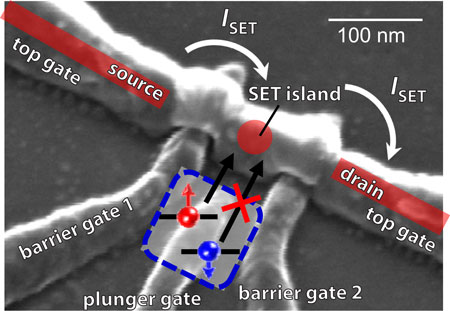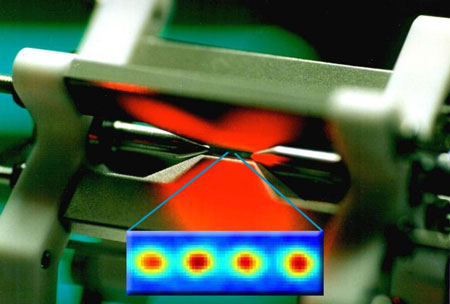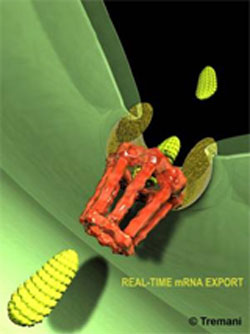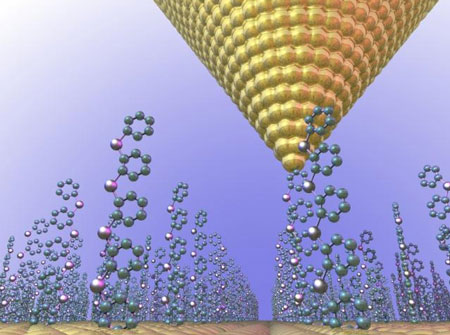 Researchers from University of New South Wales (Australia), University of Melbourne (Australia), and Aalto University (Finland) have succeeded in demonstrating a high-fidelity detection scheme for the magnetic state of a single electron, that is, the spin.
Researchers from University of New South Wales (Australia), University of Melbourne (Australia), and Aalto University (Finland) have succeeded in demonstrating a high-fidelity detection scheme for the magnetic state of a single electron, that is, the spin.
Sep 27th, 2010
Read more
The study aimed to review the basic principles, application and the potential health implications associated with the use of nanotechnology in the food sector, particularly on food and food contact materials incorporated with nanomaterials.
Sep 27th, 2010
Read more
 The entanglement of quantum objects can take surprising forms. Quantum physicists at the University of Innsbruck have investigated several flavors of entanglement in four trapped ions.
The entanglement of quantum objects can take surprising forms. Quantum physicists at the University of Innsbruck have investigated several flavors of entanglement in four trapped ions.
Sep 27th, 2010
Read more
 By constructing a microscope apparatus that achieves resolution never before possible in living cells, researchers at Albert Einstein College of Medicine of Yeshiva University have illuminated the molecular interactions that occur during one of the most important 'trips' in all of biology: the journey of individual messenger Ribonucleic acid (RNA) molecules from the nucleus into the cytoplasm (the area between the nucleus and cell membrane) so that proteins can be made.
By constructing a microscope apparatus that achieves resolution never before possible in living cells, researchers at Albert Einstein College of Medicine of Yeshiva University have illuminated the molecular interactions that occur during one of the most important 'trips' in all of biology: the journey of individual messenger Ribonucleic acid (RNA) molecules from the nucleus into the cytoplasm (the area between the nucleus and cell membrane) so that proteins can be made.
Sep 27th, 2010
Read more
 In a major physics breakthrough with international significance, University of Otago scientists have developed a technique to consistently isolate and capture a fast-moving neutral atom - and have also seen and photographed this atom for the first time.
In a major physics breakthrough with international significance, University of Otago scientists have developed a technique to consistently isolate and capture a fast-moving neutral atom - and have also seen and photographed this atom for the first time.
Sep 27th, 2010
Read more
The International Academy of Science, Engineering and Technology (International ASET) and the University of Ottawa are pleased to organize the 2nd International Conference on Nanotechnology: Fundamentals and Applications. The conference will take place in Ottawa, Canada, 27-29 July 2011.
Sep 27th, 2010
Read more
Using optically dense, ultra-cold clouds of rubidium atoms, researchers have made advances in three key elements needed for quantum information systems - including a technique for converting photons carrying quantum data to wavelengths that can be transmitted long distances on optical fiber telecom networks.
Sep 26th, 2010
Read more
The National Cancer Institute (NCI) has awarded five-year, multi-institution grants in continued support of its Alliance for Nanotechnology in Cancer program. The Alliance is engaged in efforts to leverage the specific advantages of nanotechnology to improve the way we diagnose, treat, and prevent cancer. Given the progress to date, the NCI approved a second phase of the program with an investment of approximately $30 million per year for the next five years.
Sep 24th, 2010
Read more
Today, IBM researchers published a breakthrough technique that measures how long a single atom can hold information, and giving scientists the ability to record, study and 'visualize' extremely fast phenomena inside these atoms.
Sep 24th, 2010
Read more
 Physicists have discovered a new way of harvesting waste heat and turning it into electrical power. Taking advantage of quantum effects, the technology holds great promise for making cars, power plants, factories and solar panels more efficient.
Physicists have discovered a new way of harvesting waste heat and turning it into electrical power. Taking advantage of quantum effects, the technology holds great promise for making cars, power plants, factories and solar panels more efficient.
Sep 24th, 2010
Read more
A team led by a North Carolina State University researcher has shown that water-gel-based solar devices can act like solar cells to produce electricity. The findings prove the concept for making solar cells that more closely mimic nature. They also have the potential to be less expensive and more environmentally friendly than the current standard-bearer: silicon-based solar cells.
Sep 24th, 2010
Read more
 Researchers have introduced a new kind of fuel cell: an organometallic fuel cell that efficiently converts alcohols and sugars into carboxylic acids.
Researchers have introduced a new kind of fuel cell: an organometallic fuel cell that efficiently converts alcohols and sugars into carboxylic acids.
Sep 24th, 2010
Read more
Ziel der Projekte ist es, die humantoxikologischen Aus- und Wechselwirkungen bei der Herstellung, Verarbeitung und Anwendung von synthetischen Nanomaterialien systematisch zu erforschen.
Sep 24th, 2010
Read more
The NanoKTN has announced the publication of its UK Nanotechnology Directory, a guidebook to the UK's world-class micro and nanotechnology (MNT) sector, featuring over 400 organisations active in nanotechnology in the UK.
Sep 24th, 2010
Read more
STMicroelectronics, the leader of the EU Sixth Framework Program PULLNANO Advanced Technology Research and development project, today announced that PULLNANO has been selected and invited to be demonstrated at ICT 2010, an event organized by the European Commission and hosted by the Belgian Presidency of the European Union, to be held on September 27-29, 2010 in Brussels.
Sep 24th, 2010
Read more
A portable MicroKit system developed by the Institute of Bioengineering and Nanotechnology (IBN), the world's first bioengineering and nanotechnology research institute, enables mass health screenings to be conducted at strategic locations such as airports, immigration checkpoints and train stations.
Sep 24th, 2010
Read more
 Researchers from University of New South Wales (Australia), University of Melbourne (Australia), and Aalto University (Finland) have succeeded in demonstrating a high-fidelity detection scheme for the magnetic state of a single electron, that is, the spin.
Researchers from University of New South Wales (Australia), University of Melbourne (Australia), and Aalto University (Finland) have succeeded in demonstrating a high-fidelity detection scheme for the magnetic state of a single electron, that is, the spin. 





 Subscribe to our Nanotechnology News feed
Subscribe to our Nanotechnology News feed